Yolanda is one of our newest TruBe trainers specialising in Personal Training and Ballet Fit. She holds extensive skills in calisthenics as well as TRX making her an expert in improving flexibility, strength and muscle tone. As a professional dancer she has over 10 years experience being part of world famous Lion King at the Lyceum Theatre.
Why did you sign up to be a TruBe Trainer?
I want to empower people by helping them take control of their health and fitness goals. The benefits of training are not just limited to improving your physique. The confidence gained and the mental satisfaction that clients enjoy from reaching targets and exceeding their own expectations surpasses this. TruBe provides a flexible and accessible way of allowing me to share this.
What is your biggest client success story?
A client came to me with a goal which was purely to lose weight. I shifted the focus towards skill based goals alongside her weight loss goals. This transformed her physique, but most importantly improved her mindset. She fell in love with her training and gained the knowledge and confidence to maintain that level of fitness in her lifestyle. She learned to embrace her body and feel proud of what it was capable of.
What is your greatest achievement?
Establishing a career as a performer in the west end and coming back stronger after an injury, which caused me to be on crutches for six weeks.

What is your favourite way to finish off the end of a session?
An intense core finisher followed by a relaxing deep stretch.
How do you motivate yourself and do you have a favourite motivational quote?
My favourite motivational quotes are “a comfort zone is a beautiful place but nothing ever grows there” and “strong body = strong mind”. Variety is the key to motivation for me. I like to do a bit of everything from ballet fit, callisthenics, strength training to yoga in my training. This keeps things fresh and challenges my body and mind. I always have a lot of goals on the go and I love to immerse myself in making them happen. If motivation wavers, discipline is my go to!

How do you find balance in your life?
As a trainer and performer, it’s so wonderful to do a job you love, but it’s important to take time out with friends and family. I also ensure I make time to train for myself, as that’s my meditation. I’m working on listening to my body, when my body tells me to rest, I know I need to before it forces me to!
How do you treat yourself?
Dinner with friends and maybe the odd purchase of some new training gear!!!
To book a session with Yolanda, download the app and find her as one of our featured trainers.


















